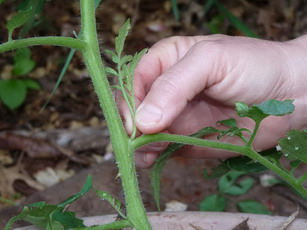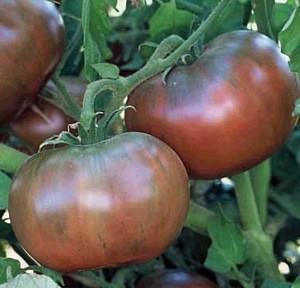The definition of summer should include the word
tomato. While I have been eating frozen,
roasted tomatoes and dehydrated tomatoes over the winter and spring, it has
been awhile since I inhaled the wonderful aroma of a tomato plant. This week
marked the estimated last frost date and we jumped right into tomato season as
we distributed plants. During our Tuesday evening Grow Appalachia meeting we
focused the majority of our attention on tomatoes: How to recognize tomato
blight, how to prevent tomato blight, and how to treat tomato blight symptoms.
This conversation focused on mulching, pruning, trellising and organic
fungicides. During the first two years of the Grow Appalachia program I have
had the opportunity to visit the homes of countless families, work alongside
them and share in some wonderful food. I have also seen many gardens afflicted
with fungal diseases. I have met many gardeners who do not even know that they
have blight in their gardens, because it seems so normal. Now, I am not going
to claim that we can completely prevent this affliction, but I would like to
encourage gardeners to think about the inevitability of this problem now, and
start taking action.
What is tomato blight? I wrote a blog post about this last summer that you can read for an overview.
There are also many other sources for information on the internet, such as Cornell. Think about the methods you plan to use to control it right now.
The above resources have links to sites which lay out ideas for preventing the
spread of disease, so I am just going to highlight trellising and pruning tomatoes.
Stake and trellis your tomato plants! The fungal diseases we
have problems live in the soil and can be spread by contact with the soil
surface. By keeping your plants off the ground they are easier to manage and
less likely to get soil all over them. Tying up your plants also makes it
easier for you to navigate through your garden and keeps fruit off of the
ground.
Trellising methods:
Many gardeners tie each tomato to a stake with strips of cloth, etc. This is
completely fine and keeps your tomatoes growing upright. However, I would like
to spread the word about the Florida weave method of trellising tomatoes. This
method only requires one tomato stake for every two plants, is quick, easy, and
keeps your tomatoes growing beautifully. There is a video from the University of Maine demonstrating this method and an article that explains in words how to use the Florida weave.
*Note on the University of Maine video: This video shows him
weaving the string around each plant. This is great, but not required for this
type of system. Pulling the string along the outside of each plant until you
get to the end of the row and then pulling along the inside of the plants works
just fine and is easier. Read this article for further explanation.
Pruning: There
are two main reasons to prune tomato plants. One reason is to help prevent
fungal spores from splashing onto the bottom leaves of the plant and spreading
blight. To prune for disease prevention, clip the bottom leaves of the plant
off as they bend downward and get close to the soil surface. If you have ever
seen the progression of early blight, you have seen the bottom leaves turn
yellow and brown first and the disease spread upward.
The second type of pruning is to remove the suckers off of a
plant. A sucker is a side shoot off of the main stem. They develop in the leaf
axils of the plant, between the main stem and a leaf. On indeterminate varieties gardeners should
remove these suckers so that they do not take away energy from the main stem.
The indeterminate plants will continue to grow vertically and produce new fruit
clusters on the main stem. Removing these side shoots also keeps your plants
from becoming extremely bushy and hard to manage and tie up. This will also
increase airflow through the plants, helping to prevent disease. The first three minutes of this video has a
wonderful explanation of how to sucker your plants. If you do not have access
to internet that allows you to watch videos, you can read this detailed article
about pruning.
When removing suckers, you should know whether your plants
are indeterminate or determinate. Indeterminate tomato varieties keep growing
throughout the growing season and produce fruit until the vines die. These tomatoes
need to be staked since they will not stop growing until they die.
Indeterminate tomatoes should be pruned to remove the suckers. Determinate
tomatoes have a bushy form, stop growing once fruits begin to fill out and
produce their fruit within the timeframe of a few weeks. These tomato varieties
should not be pruned to remove suckers. Since these varieties have a bushier
form and do not grow as tall, some people say that these do not need to be
staked, however, I encourage gardeners to keep them up off of the ground to
help prevent the spread of fungal diseases and keep fruit from rotting.
Here is a little information about the tomato varieties we
offered to participants this year. We received beautiful plants from the
Friendly Village Mountain Comprehensive Care Greenhouse in Harlan and fellow
Grow Appalachia site, Henderson Settlement.
Arkansas Traveler:
Indeterminate. Open pollinated. This variety has good disease resistance,
beautiful round pink fruits, and great flavor. Does well in adverse conditions
without cracking.
Beefsteak: Indeterminate. Open pollinated. Popular old
time heirloom with large red, meaty fruits.
Big Boy: Indeterminate.
This variety was one of the first hybrids, introduced in 1949. Produces a
large, smooth, red, meaty fruit.
Brandywine:
Indeterminate. Open pollinated. Brandywine tomatoes produce large, beefsteak,
pink fruits. This heirloom is a potato leaf variety grown among the Amish in
the 1800s. It was one of the first heirlooms to become popular in recent years.
This variety can be frustrating because it is pretty early blight susceptible
and prone to cracking, however, many gardeners stick with this variety because
of its delicious taste.
Cherokee Purple:
Indeterminate. Open pollinated. This heirloom variety was grown by the Native
American Cherokee tribe in Tennessee.
These plants produce beefsteak type purplish brown fruits with dark
green shoulders. Since the beginning of the Grow Appalachia program at PMSS,
this variety has become a favorite among participating gardeners because of its
wonderful flavor. Some people think that these plants should not be pruned to
prevent sunburn on the fruits.
German Queen:
Indeterminate. Open pollinated. Heirloom tomato producing 1-2lb pinkish red
fruits! A potato leaf variety.
Golden Jubilee: Indeterminate. Open pollinated. This is an old standard variety with nice, tangy, mild flavor.
Great White:
Indeterminate. Open pollinated. This beefsteak heirloom tomato is white and has
a melon-like flavor!
Matt’s Wild Cherry:
Indeterminate. Open pollinated. This variety is one of the most early blight
resistant, and it’s an heirloom! It genetically linked to wild Mexican
tomatoes. These plants also have some frost resistance. Plants produce
thousands of sweet, red ½ inch fruits in clusters.
Mr. Stripey: Indeterminate.
Open pollinated. Large, beefsteak heirloom tomato. A favorite among PMSS Grow
Appalachia participants. A low acid tomato with mottled red and yellow flesh.
Roma: Indeterminate. Open pollinated. A paste tomato with thick flesh. Popular old time
tomato.
Rutgers: Indeterminate.
Open pollinated. This variety was originally bred by the Campbell’s soup
company in 1928 as a cross between Marglobe and JTD varieties. This variety is
great for canning, cooking, and slicing. Good disease resistance for an open
pollinated variety.
Pineapple:
Indeterminate. Open pollinated. This heirloom is originally from Kentucky. A
low acid tomato with a unique flavor. When you cut this variety in half it
looks like the inside of a pineapple with yellow and red marbling.
Violet Jasper: Indeterminate. Open pollinated.
Originally from China, these tomatoes have purple fruit with iridescent green
stripes. Smooth, small round fruits with dark purplish red flesh. High
productivity.
Yellow Pear: Indeterminate. Open pollinated. 1 ½ inch, pear
shaped fruits. Very productive.
Interested in heirloom varieties from central Appalachia? Read this post from the Sustainable Mountain Agriculture Center.





Awsome blog Maggie! alot of great information thanks again!
ReplyDeleteChad Brock